To create professional-grade perfume oils, you'll need precise dilution ratios based on your desired strength. For Eau de Parfum, start with a 15-20% concentration using 2-4 grams of essential oils per 10ml of carrier oil. Always measure by weight instead of drops, and follow the 30/50/20 rule for balancing top, middle, and base notes. Store your blends in dark glass bottles at 65-75°F, and document every measurement for consistent results. These foundational tips will initiate your journey into expert perfume creation.
Understanding Base Dilution Percentages for Perfume Oils
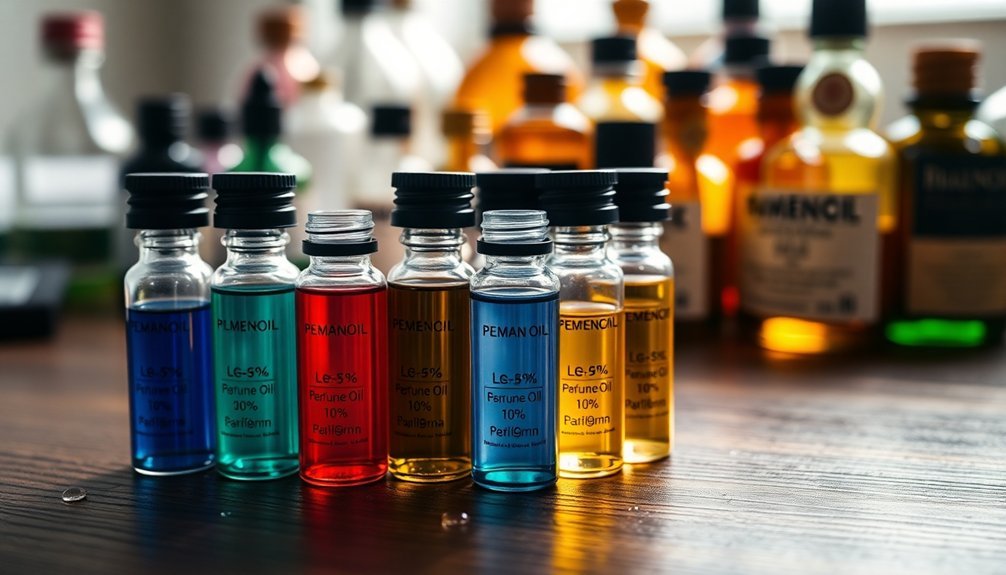
The art of perfume-making hinges on precise dilution ratios that determine a fragrance's strength and wearability.
Perfumery is a delicate science where precise measurements and careful dilutions transform raw scents into wearable fragrances.
When you're crafting perfumes, you'll need to master base note dilutions that typically range from 1% to 30%, with 10% serving as a standard benchmark for Eau de Parfum formulations.
For a proper oil dilution, you'll want to weigh your ingredients rather than measure by volume.
If you're aiming for a 10% concentration, combine 10 grams of essential oil with 90 grams of carrier, while a 20% blend requires 20 grams of oil to 80 grams of carrier.
For a 10ml atomizer, you can create an Eau de Parfum by mixing 20% essential oil with 70% alcohol and 10% distilled water.
Essential Carrier Oils and Their Blending Properties
When creating perfumes, selecting the right carrier oil forms the foundation of a successful blend.
You'll need to understand each carrier oil's unique properties to achieve the best results. Grapeseed oil works well for lighter blends, while jojoba's thicker consistency makes it perfect for longer-lasting fragrances.
To dilute your perfume oils safely, follow the 2% dilution rule: use two drops of essential oil per teaspoon of carrier oil.
This ratio helps prevent skin irritation and guarantees proper blending. Before applying your creation, always perform a patch test to check for any sensitivities.
Remember that your carrier oil's shelf life affects your perfume's longevity.
Choose oils containing vitamin E for better preservation, and store them properly to prevent oxidation.
Never skip the dilution process, as undiluted oils can harm your skin.
Measuring Techniques for Precise Oil Ratios
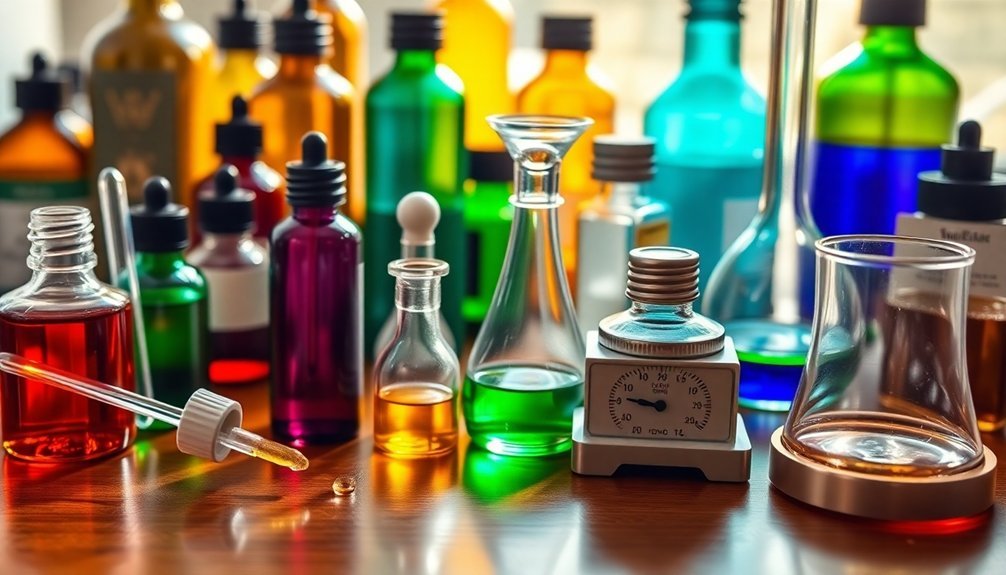
Precise measurements stand at the heart of successful perfume creation. To guarantee essential oils are safe and properly diluted, you'll need a scale that measures to two decimal points.
Don't rely on counting drops, as different oils have varying weights per drop. When working with a 10ml atomizer, you're dealing with approximately 200 drops total.
Drop counting is an unreliable method for perfume making, as oil densities vary significantly. A 10ml container holds roughly 200 drops.
For accurate measuring techniques, remember that alcohol's density of 0.789g/cm³ affects your calculations. Instead of using volume measurements, always weigh your ingredients for consistent results.
For a perfect 10% dilution, you'll want to add 2.5 grams of essential oil to your 30ml bottle, then fill with ethanol until you reach 25 grams total weight.
This weight-based approach guarantees your blends are precise and reproducible every time.
Professional Concentration Standards by Fragrance Type
Professional perfume concentrations range from light Eau de Toilette at 5-15% fragrance oils to the more intense Eau de Parfum at 20% essential oils.
You'll need to calculate precise measurements when creating these formulations, such as using 40 drops of essential oils per 10ml for a balanced fragrance profile.
Understanding these standard ratios will help you achieve consistent results, whether you're working with a 10% dilution that requires 2.5 grams of essential oil per 22.5 grams of ethanol, or crafting other fragrance strengths.
Standard Perfume Strength Categories
Three main categories define professional perfume strength standards: Eau de Toilette (EdT), Eau de Parfum (EdP), and Parfum.
You'll find EdT contains the lightest concentration at 5-15% of aromatic compounds, making it perfect for daily wear.
When you're looking for something more intense, EdP offers a 15-20% concentration.
To create an EdP, you'll need to dilute essential oils at a ratio of 20% oil, 70% alcohol, and 10% distilled water. This creates a balanced, long-lasting fragrance that's still suitable for regular use.
For the strongest option, Parfum contains 20-40% concentration of aromatic compounds.
You'll achieve this potency by using 30-40% essential oils in your blend.
Understanding these categories helps you select the right strength for any occasion.
Fragrance Concentration Measurement Ratios
Understanding fragrance concentration ratios is vital for creating perfectly balanced perfumes. When you're working with essential oils, you'll need to master specific dilution ratio standards to achieve professional results.
The most common Eau de Parfum formula uses a 20% essential oil concentration mixed with 70% alcohol and 10% water.
- For a 10ml atomizer, use 40 drops of essential oils with 140 drops of alcohol
- Create a 10% solution by combining 2.5g essential oil with 22.5g ethanol
- Parfum concentrations require 30-40% essential oils for maximum intensity
- Eau de Toilette formulations typically contain 5-15% essential oils
- Always measure and record exact weights for consistent future blends
These standardized ratios guarantee your fragrances meet industry expectations while maintaining proper safety and scent strength.
Remember to adjust your dilution ratio based on the specific fragrance category you're creating.
Safety Guidelines for Different Oil Strengths

When working with perfume oils, you'll need to follow specific concentration guidelines, starting with a 2% dilution for general use and only increasing to 10% for localized adult applications.
Before applying any diluted oils to your skin, you must perform a patch test on a small area to check for potential reactions or sensitivities.
If you're new to essential oils, start with the lowest recommended concentration (1%) and gradually increase the strength while monitoring your skin's response.
Essential Oil Concentration Levels
Safe and effective use of essential oils depends primarily on proper dilution ratios. For most skin applications, you'll want to aim for a 2% dilution, which means adding two drops of essential oil per teaspoon of carrier oil. If you're using a 10ml bottle, that's five drops of essential oil.
- Start with a 1% dilution (one drop) if you have sensitive skin or are new to essential oils.
- Higher concentrations up to 10% can be used on small areas for adults only.
- No dilution is needed when diffusing or adding oils to baths.
- Always perform a patch test before applying any new oil blend to your skin.
- Choose from carrier oils like Sweet Almond, Jojoba, Argan, Grapeseed, or Fractionated Coconut Oil for best results.
Proper Dilution Testing Methods
Before applying any new essential oil blend to your skin, proper dilution testing helps prevent adverse reactions and guarantees safe use across different concentration levels.
Start by conducting a patch test using a 2% dilution – mix two drops of essential oil with one teaspoon of carrier oil. Apply this mixture to a small area of your inner arm and monitor for 24 hours. If you don't experience any irritation, you can proceed with regular use.
For stronger blends up to 10%, test on a tiny skin area first, but only use these higher concentrations in specific, localized applications.
Remember to dilute more potent oils at 1% concentration initially. While you don't need to dilute oils for diffusing or bath use, never apply undiluted essential oils directly to your skin to avoid sensitization or irritation.
Skin Sensitivity Precautions
Understanding your skin's sensitivity to essential oils requires careful attention to dilution ratios and individual tolerance levels. You'll need to dilute your oils properly to prevent irritation and adverse reactions.
Start with a conservative 2% dilution, which means using two drops of essential oil per teaspoon of carrier oil. If you're considering higher concentrations, limit them to small areas and proceed with caution.
- Always perform a patch test before applying any diluted mixture to larger areas
- Begin with lower concentrations and gradually increase if needed
- Consider your individual skin sensitivity when choosing dilution ratios
- Monitor your skin's response to different oil combinations
- Remember that sensitivity can vary based on the specific oil's source and quality
These precautions help guarantee safe and effective use of essential oils while minimizing the risk of skin reactions.
Scaling Your Perfume Oil Formulas
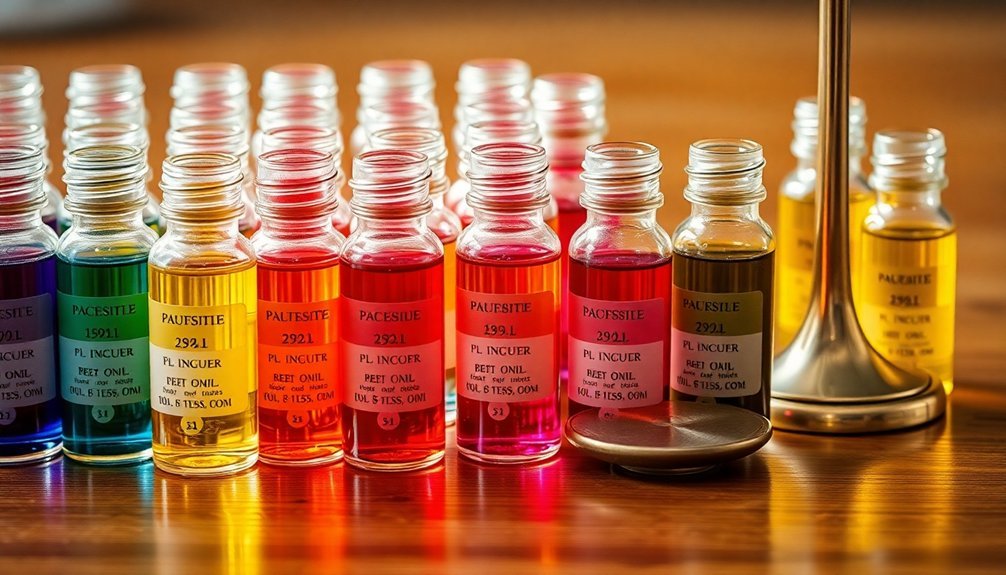
Mastering the art of scaling perfume oil formulas requires meticulous attention to dilution ratios and precise measurements.
When you dilute essential oils, maintaining consistent proportions is vital for achieving reliable results. For example, if you're working with a 40% dilution, use 4g of oil and 6g of alcohol for every 10g of final product.
To scale your formulas accurately, you'll need a scale with at least two decimal points. For a 30ml bottle at 10% dilution, measure 2.5 grams of essential oil and add ethanol until reaching 25 grams total.
Always document your concentrations and ingredient weights meticulously. When adjusting strength, you can increase concentration using pure or 50% diluted materials, while decreasing concentration requires additional ethanol to achieve your target strength.
Storage Requirements for Diluted Blends
Your diluted perfume blends need proper storage in temperature-controlled dark spaces, ideally between 65-75°F (18-24°C), to maintain their aromatic integrity and prevent degradation.
You'll want to choose amber or cobalt blue glass bottles with airtight seals to protect your blends from harmful light exposure and minimize evaporation.
Store these containers in a dedicated cabinet or drawer away from direct sunlight and heat sources, checking them periodically for any changes in scent or consistency.
Temperature-Controlled Dark Spaces
Proper storage of diluted perfume oil blends requires a carefully controlled environment to maintain their quality and potency. You'll need to store your blends in temperature-controlled dark spaces at 15-20°C (59-68°F).
Once you've created your blend, let it sit undisturbed for at least a week to achieve ideal maturation.
- Choose amber or cobalt blue bottles to protect oils from light exposure
- Maintain consistent temperature between 15-20°C (59-68°F)
- Keep storage area dry and humidity-free
- Position blends away from heat sources like stoves and radiators
- Allow blends to rest for one week before evaluating
These storage conditions aren't just suggestions – they're essential for preserving your blend's fragrance and therapeutic properties.
Temperature fluctuations and light exposure can quickly degrade your oils, so proper storage is vital for maintaining their quality over time.
Airtight Container Selection
Beyond temperature control, selecting the right container determines the success of your diluted perfume oil storage.
You'll need to choose airtight containers made specifically of glass, as plastic can react with your essential oils and compromise their quality. Opt for amber or cobalt blue bottles that shield your blends from harmful light exposure.
When you're setting up your storage system, make certain to label each container with detailed information about the blend's ingredients and dilution ratios.
This practice helps you track the aging process and maintain consistency in your perfume making.
Don't forget to regularly inspect your bottle seals to prevent unwanted evaporation or contamination. A tight seal guarantees your carefully crafted blends remain fresh and potent for their intended lifespan.
Balancing Top, Middle, and Base Notes
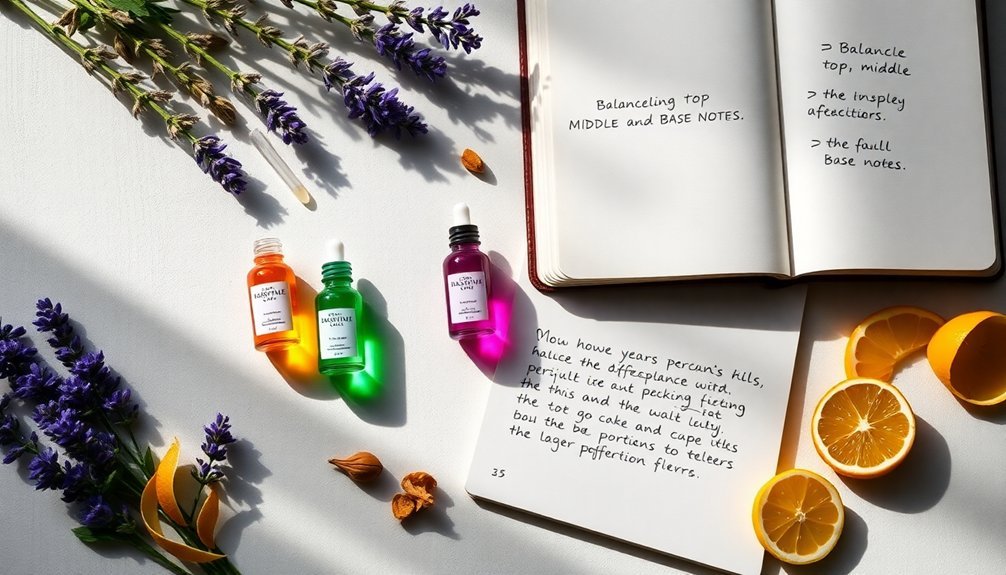
Creating a harmonious perfume blend requires understanding the delicate interplay between fragrance notes. When blending essential oils, you'll want to follow the 30/50/20 rule to achieve a balanced composition. This means using 30% top notes, 50% middle notes, and 20% base notes in your mixture.
- Top notes like Bergamot and Sweet Orange provide initial freshness but evaporate quickly.
- Middle notes such as Lavender and Clary Sage form the heart of your blend.
- Base notes including Ylang Ylang and Cedarwood add lasting depth.
- The 30/50/20 ratio guarantees a well-structured fragrance profile.
- Experimenting with different note combinations helps you discover your signature scent.
Remember that balancing top, middle, and base notes isn't just about following rules—it's about creating a symphony of scents that evolves beautifully over time.
Testing Methods for Optimal Dilution Rates
Testing your perfume dilutions accurately guarantees both safety and ideal fragrance performance.
Precise measurements and proper testing protocols are essential steps in creating safe, high-quality perfumes that perform as intended.
When you're ready to dilute essential oils, use a precise scale that measures to two decimal points rather than relying on volume measurements. For a 10% dilution, combine 2.5 grams of essential oil with ethanol in a 30ml amber bottle until you reach 25 grams total.
To evaluate your blends effectively, apply them to fragrance strips or cotton balls for initial testing. You'll want to let your creations mature for at least 48 hours to achieve their true scent profile.
Before applying any blend to your skin, always conduct a patch test with the diluted mixture to prevent potential irritation. This methodical approach guarantees you'll create safe, well-balanced fragrances every time.
Troubleshooting Common Dilution Mistakes
While perfume oil dilution may seem straightforward, several common mistakes can compromise your final product.
When you need to dilute essential oils, precision is essential for both safety and effectiveness. Here are significant tips for creating successful blends and avoiding common pitfalls.
- Always use a scale instead of volume measurements, as density variations can affect your ratios.
- Document every measurement precisely, including the weight of each component.
- Account for alcohol density (0.789g/cm³) when using ethanol as your carrier.
- Test your diluted blend on a small patch of skin before full application.
- Monitor your concentration percentages carefully when adjusting existing blends.
Frequently Asked Questions
What Is the Ratio for Blending Perfume?
You'll want to use a 20-70-10 ratio for your perfume blend: 20% essential oils, 70% alcohol, and 10% distilled water. For a 10% dilution, mix 2.5g essential oil with 22.5g ethanol.
What Is the 30/50/20 Rule for Perfume?
You'll create balanced perfumes by following the 30/50/20 rule: use 30% top notes for initial scent, 50% middle notes for harmony, and 20% base notes for lasting depth in your fragrance blend.
What Percentage of Oil Is Dilution for Perfume?
You'll typically want a 20% dilution for perfume oil, which means using 40 drops of essential oil in a 10ml bottle. For a milder scent, you can opt for 10% dilution in eau de parfum.
What Is the 30/50/20 Rule for Essential Oils?
You'll create balanced essential oil blends by using the 30/50/20 rule: combine 30% top notes (fresh scents), 50% middle notes (heart of fragrance), and 20% base notes (grounding elements) for a harmonious result.
In Summary
You'll find that mastering perfume oil dilution takes practice and patience. Start with small batches using the recommended ratios, and don't be afraid to adjust until you achieve your desired scent strength. Keep detailed notes of your successful blends, maintain proper safety protocols, and always store your creations correctly. With these expert tips, you're well-equipped to create professional-quality perfume oil dilutions.
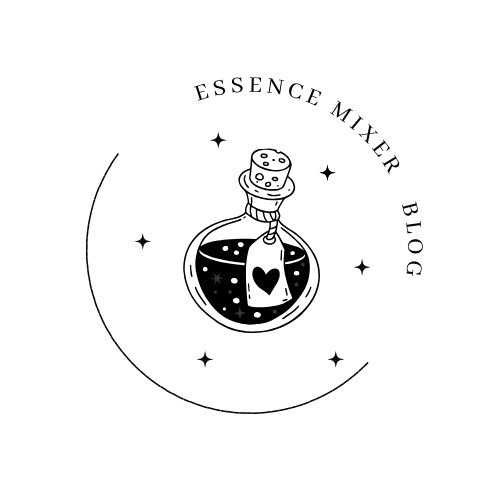


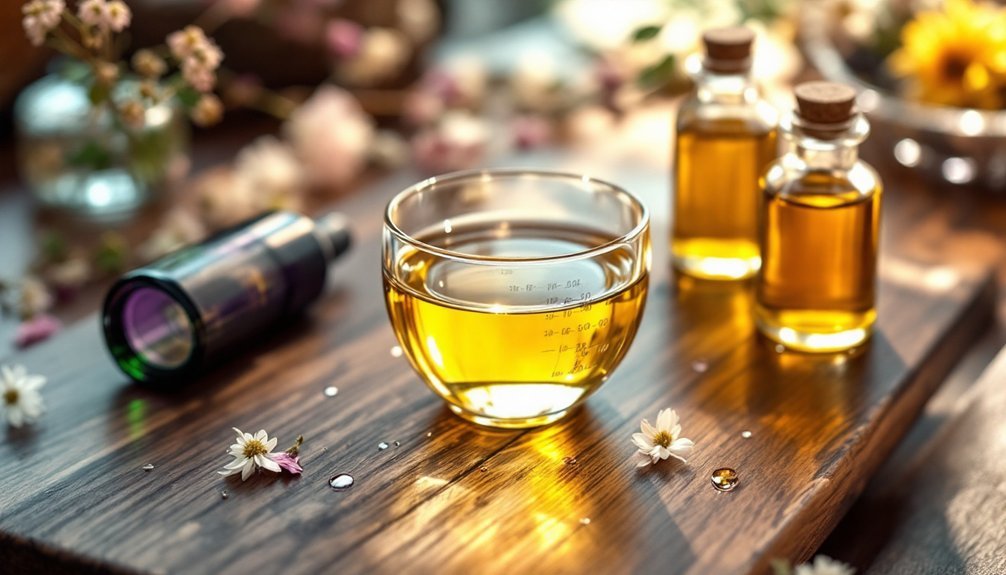
Leave a Reply